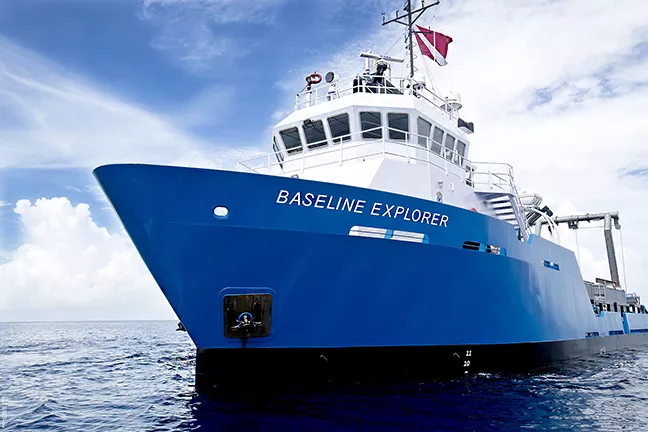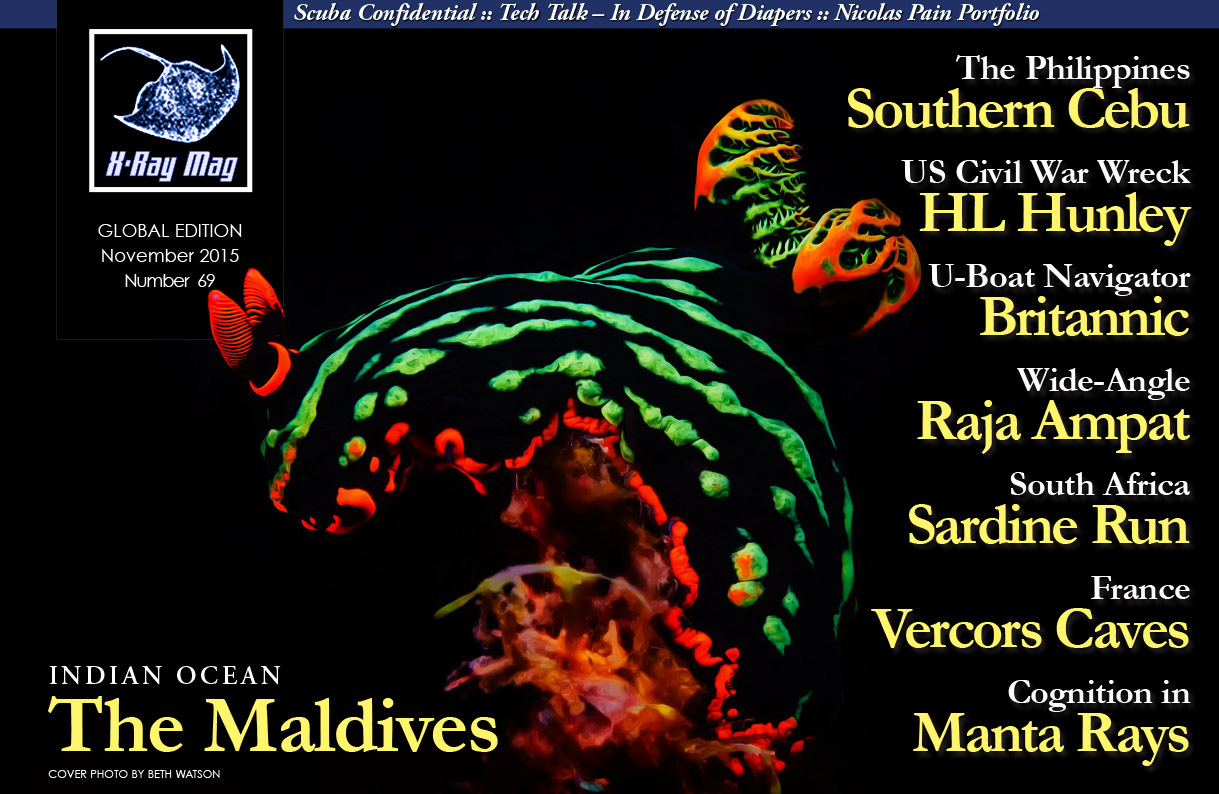Project Baseline works by organizing and mobilizing a global network of highly skilled and passionate divers to create a lasting visual legacy of underwater environmental conditions one photo and one video at a time. Their images, descriptions, and data are moved into an online database designed to render their observations accessible to the world. Their images create a baseline for environmental quality. When stitched together, those images create a time lapse revealing how that quality is changing.
Contributed by
The underwater world is elusive. In a statement of stunning over-simplification, its inaccessible reaches are a great source of both mystery and inspiration.
Consider the whole of things, living and inanimate, that inhabit the vast five oceans and smaller seas. Ponder the lakes that take up an entire horizon line or span barely more than a few swimming pools, or the rivers that mingle and intertwine as spider webs across land masses, their sources reaching high into mountain ranges or present at an unremarkable lake outlets.
Then there are the springs and swallets—portals to underground rivers that flow out of sight and continuously fill underground aquifers where balanced “water budgets” allow. Many flooded cave passages along with the rest of these underwater environments remain unexplored with reaches unknown.
Water is pure energy moving on top of, across and through our planet as raindrops, waves, rivers and currents—evaporating, condensing and falling back to the earth’s surface. It is in motion, constantly in flux, shape-shifting and responding to the queues it takes from its surroundings near and far. It is under the influence of paleoclimatic and anthropogenic factors persisting year in and year out.
Progress and pollution
In the western United States, Lake Tahoe absorbs most of the nitrogen now present in levels damaging to its long-term health, from the air. Exhaust from the automobiles of some 55,000 residents and an estimated four million visitors annually are often trapped in the mountain basin where the lake sits. The gas settles on the surface and leeches its way into the chemical composition of those internationally famous clear waters.
In the Florida Keys, the archipelago that was once a series of discrete islands is now connected by a highway running straight through it, which means that more people can easily reach this once seldom-visited territory. Scientists who study the near-shore coast in the Keys no longer consider the underwater ecosystem a scientifically defined coral reef. Today, less than five percent of the coral reef is alive in the Keys. The once wild and dynamic underwater ecosystem cannot survive the increased nitrogen and phosphorous loads coming from land-based sources. Reefs are covered by a smothering mono-culture of algae and sponges.
Defining what is pristine
And what of water’s response to a stage that has been set for lasting health? In a study published last year in Nature, scientists collectively identified five key features of successful Marine Protected Areas (MPAs.) It was reported that MPAs with all five features showed a 224 percent increase in fish biomass; over an 800 percent increase in large fish, grouper, and jack biomass; and a nearly 2,000 percent increase in shark biomass. A remarkable and potentially lasting rebound of underwater conditions.
But how do we know where normal or pristine ecological health begins? When or where do we start to observe and measure changes? Is a 224 percent increase in fish biomass truly a remarkable increase, or are we just revisiting the historical norm for which we have no record?
To what environmental state, exactly, will the residents and visitors in the Florida Keys decide to restore their coastal waters? The one that was present before the first US Navy settlement was established in 1822? Or perhaps to the one existing just before the island-linking highway was completed in 1938, which helped pave the way for around four million annual visitors in 2014? As a newcomer to the Keys, do we begin now and congratulate ourselves on preserving a largely dead coral reef from an even further state of decline?
Establishing baselines
The starting point, or “baseline”, for environmental norms underwater are in many places elusive. Our planet’s wet, saturated and uninhabitable landscape is so challenging for humans to access, so expensive, so potentially life-threatening and so remote, that much of the baseline data required to inform the public about a historically “pristine”, or at least sustainable environmental condition, is simply not available.
A lack of cultural and institutional knowledge about what an underwater environment originally looked like leads to a misinformed public on a global scale.
Dr Daniel Pauly, Principal Investigator of the Sea Around Us Project, spent time observing fisherman in Ghana whose survival depended on catching tilapia averaging 20cm in length in the early 1970s. Just one generation later, fisherman were still subsisting on the same fishery, but with tilapia sizes averaging just 5cm. As a result, the fishermen’s quality of life has not been substantially diminished, but a father’s fishing experience is not the same as his son’s or daughter’s. Pauley brings this research to life in a simple but sweeping statement: “So nothing has changed and yet everything has changed.”
Documenting change
How do we share what our common experiences and interactions with the underwater world are like as the years go by? Do we write in our journals? Save samples of fish bones and preserved coral tucked into glass cases? Do we take pictures and post them to Facebook? Do we meticulously record every detail and plot growth and contractions on a graph and file our findings in a report? Do we sit down and tell our grandchildren how things used to be, faulty, subjective memories and all?
Project Baseline is the first volunteer, citizen science organization dedicated to addressing the phenomenon of “shifting baselines”, in the field of conservation psychology referred to as environmental generational amnesia, in underwater environments on a global scale. It is an endeavor to connect people with the alarming changes that are occurring in our underwater world, from mountain lakes to ocean reefs and all waters in between. The documentation initiative aims to provide the people who can see these places and these changes, often certified scuba divers, with an effective voice to promote and support much needed and forever sustained conservation.
When volunteer divers are coupled with scientists and resource managers struggling to understand and protect the ecosystems where communities of divers are present, the collective effort becomes greater than the sum of its parts.
Project Baseline’s goals are simple:
• Build a platform to permanently record diver observations through image media and numeric data;
• Encourage volunteer divers to direct some of their endless energies toward perpetually populating that platform;
• Then use their images and data to foster environmental baselines in every type of underwater environment across the globe.
Action
As of July 2015, Project Baseline has 64 active projects spanning 28 countries. In most cases, what began as the interest and effort of a single person or very small group has grown into small communities of similarly skilled and passionate divers that work together on a regular basis to document their sites and stations. Teams are supported by Project Baseline staff to establish a Permanent Positive Presence focused on specific water bodies and the specific challenges that confront them.
In several cases, their persistent efforts expand into productive relationships with other entities: universities, conservation organizations, and even local businesses, that have an interest in understanding and protecting the water bodies in which our teams are working.
Teams and training
Project Baseline is the central conservation initiative of a Florida-based nonprofit organization called Global Underwater Explorers (GUE). Founded in 1999 by two avid cave divers and explorers, Jarrod Jablonksi and Todd Kincaid who remain dedicated to mission-focused, team-based diver training. It was through the training component of this mission that the founders have been able to establish and sustain lasting partnerships with groups of like-minded, equally capable, and identically trained and equipped teams of explorers across the world.
Through those partnerships, GUE teams have explored all manners of environments from underwater caves to ship wrecks, from high mountain lakes to reefs and vertical walls across the globe. The organization has trained over 10,000 divers over the past 15 years and is composed of some of the best-trained, most capable, safest, and most dedicated divers on the planet.
Exploration
Repeatedly drawing from its global network of divers, Project Baseline creates teams for numerous exploration efforts in all manners of environments.
In 2014, Project Baseline added a new and powerful dimension to its mission through the acquisition of a capable research vessel, the Baseline Explorer, and two observation submersibles, Nemo and Nomad. Specifically, the goals of the Baseline Explorer is to take Project Baseline to critical places not accessible by our shore-based teams and to leverage the combination of the ship, subs and divers to establish and sustain productive collaborations with scientific institutions that will foster improved understanding of our underwater word and the much needed conservation of its fragile ecosystems.
Its ongoing mission will focus on documenting and establishing protections for shallow and meso-photic coral reefs offshore of Florida, the Bahamas, in the Gulf of Mexico and in the Northern Caribbean Sea. Future goals focus on replicating the Baseline Explorer platform and mission in every ocean and making Project Baseline a significant contributor to the global efforts aimed at marine conservation.
Looking forward
The underwater world is changing. It is degrading in very many places, yet the causes of that degradation and the consequences to the associated ecosystems go largely or even entirely unseen. In most of those places, there exists no baseline for what is pristine or even what is tolerable.
Until such baselines can be established, there can be little hope that effective local and focused conservation measures can be enacted.
Beyond those imperiled areas, there remain, however, astoundingly beautiful and thriving ecosystems in our marine and freshwater bodies that are also largely or entirely unseen, at least at the level needed to establish baselines.
At its heart, Project Baseline is a great experiment that tests the significance and role of the common but passionate citizen in the growing global struggle to protect the vast and vulnerable life beneath the waves. Project Baseline is a global community of highly skilled and passionate volunteer divers, research vessel and submersibles, and collaborations that endeavor to rectify this problem.
The program’s mission is therefore ambitious yet stunningly simple: to effect positive change within the world’s aquatic environments measureable in terms of improvement within our lifetimes and to establish the permanent positive presence across the globe that will be needed to sustain those improvements. ■
For more information, please visit: Projectbaseline.org.

































